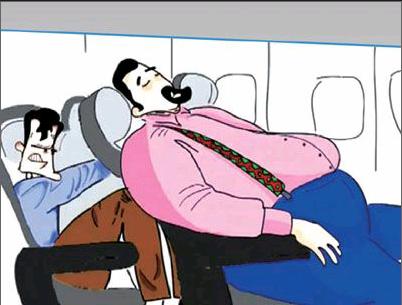The Recline and Fall of Western Civilization 座椅少倾一度,文明多进一步
2014-08-20


The woman sitting in front of me on this plane seems perfectly nice. She, like me, is traveling coach class1) from Washington to Los Angeles. She had a nice chat before takeoff with the man sitting next to her, in which she revealed she is an elementary school teacher, an extremely honorable profession. She, like me, has an aisle seat and has spent most of the flight watching TV. Nevertheless, I hate her.
Why? Shes a recliner.
For five minutes after takeoff, every passenger on an airliner exists in a state of nature. Everyone is equally as uncomfortable as everyone else. The passengers are blank slates2), subjects of an experiment in morality which begins the moment the seat-belt light turns off.
Ding! Instantly the jerk in 11C reclines his seat all the way back. The guy in 12C, his book shoved3) into his face, reclines as well. 13C goes next. And soon the reclining has cascaded4) like rows of dominos to the back of the plane, where the poor bastards5) in the last row see their personal space reduced to about a cubic foot6).
Or else7) there are those, like me, who refuse to be so rude as to inconvenience the passengers behind us. Here I sit, fuming8), all the way from IAD9) to LAX10), the deceptively nice-seeming schoolteachers seat back so close to my chin that to watch TV I must nearly cross my eyes. To type on this laptop while still fully opening the screen requires me to jam the laptops edge into my stomach.
Obviously, everyone on the plane would be better off if no one reclined; the minor gain in comfort when you tilt your seat back 5 degrees is certainly offset11) by the discomfort when the person in front of you does the same. But of course someone always will recline her seat, like the people in the first row, or the woman in front of me, whom I hate.
What option do we, the reclined-upon, have? You can politely ask the person in front of you not to recline. But then the person in front of you is filled with resentment, because he feels you have forced him to give up his comfort in favor of yours.
And it might not even work. Once, on a flight from Chicago to Honolulu12), a sweet old Hawaiian lady and her husband sat in front of me, and both reclined their seats at the very beginning of the eight-hour trip. “Excuse me,” I said. “Thats very uncomfortable. Is there any chance you could put your seat back up, at least partway?” “No!” she snapped. “We paid for these goddamn seats, and well recline them if we want to.” So then everyone was angry.
The problem isnt with passengers, though the evidence demonstrates that many passengers are little better than sociopaths13) acting only for their own good. The problem is with the plane. In a closed system in which just one recliner out of 200 passengers can ruin it for dozens of people, it is too much to expect that everyone will act in the interest of the common good. People recline their seats because their seats recline. But why on earth do seats recline? Wouldnt it be better for everyone if seats simply didnt?
Reclining seats have been with us as long as airlines began making human passengers a priority. In the 1920s and 1930s, people were an afterthought14); planes were meant to carry airmail and cargo, and any humans who wanted to come along were welcome to pay an astronomical15) fare and sit in wicker chairs. “Reclining seats were not a universal treatment until the DC-316) era,” beginning in 1935, says John Hill, assistant director in charge of aviation at the SFO Museum. In the beginning, reclining seats—along with footrests and in-seat ashtrays—were designed as part of airlines commitment to deluxe17) accommodations, as captains of industry in three-piece suits18) sipped martinis on board, stretching their legs one way and tilting their seats the other.
The seats persisted, even as airlines moved to the tiered19) service model we know now, which required packing more and more customers into economy in order to keep RPK (revenue per kilometer) high. “They didnt want to give up the idea of luxury altogether,” Hill notes. But these days, flying is simply an ordeal to be survived. In the era of cheap tickets and passengers crammed onto flights like sardines20), reclining seats make no sense.
Thats why the woman in front of me does not really deserve my hatred. Miss Manners21) agrees: the real offending party is the airline—in this case, Virgin America. They installed stylish purple lighting and sleek leatheresque seats in this A320 jet; they serve much better food than you might expect; even their in-flight safety video is endearingly written and animated. And the seats on Virgin (and every airline, really) are a marvel: “One of the most highly tuned man-made environments, period22),” Hill notes, “optimized for space and weight and safety.” But despite all these nods toward modern, customer-friendly design, Virgin still, in opposition to all that is right and good, installs reclining seats on their planes. Just like everyone else.
Some European airlines have begun installing seats that are slightly tilted in their natural resting state, which, anecdotally at least, helps convince passengers they dont need to tilt further. But that doesnt go far enough. Its time for an outright ban on reclining seats on airplanes. Im not demanding that airlines rip out the old seats and install new ones; lets just extend the requirement that seats remain upright during takeoff and landing through the entire flight. There is an actual good reason for this regulation: upright seats are safer in a crash, and allow for easier evacuation.
Of course, this whole debate has a limited shelf life23). Ten years from now, if financially strapped American carriers exist at all, theyll surely have gone the way of budget24) European airline Ryanair, with its non reclining seats—and horrifying 30-inch seat pitch25). When I fly in one of those planes of the future, will I be comfortable? Absolutely not. But I wont complain, because at least everyone else will be exactly as uncomfortable as me.
在这架飞机上,坐在我前面的女人看起来极为友好。和我一样,她坐经济舱从华盛顿飞往洛杉矶。在飞机起飞之前,她和邻座的男士进行了愉快的交谈,从中她提到自己是一名小学教师,这是一个非常光荣的职业。和我一样,她也坐在靠过道的座位上,用看电视打发大部分飞行时间。然而,我讨厌她。
为什么?因为她后倾了椅背。
在起飞后的头五分钟内,客机上的每位乘客都处于自然落座的状态。大家的不舒适度是一样的。乘客们像一张张白纸,从安全带提示灯熄灭的那一刻起开始经受一场道德的考验。
叮!坐在11C座位上的蠢货立即将椅背向后倾斜到最大程度,坐在12C座位上的家伙的书被挤到脸上,于是他也向后倒去。接着是13C。不一会儿,椅背如一排排多米诺骨牌般朝飞机尾部倒去,坐在最后一排的可怜的家伙们只能眼睁睁地看着自己的空间被缩小到约一立方英尺。
也有一些人,他们和我一样拒绝做出如此粗鲁的行为,以免给后面的乘客带来不便。我坐在那里,从华盛顿机场到洛杉矶机场全程都愤怒无比。那个徒有和善外表的小学教师的椅背是如此靠近我的下巴,以致我看电视时几乎得用“斗鸡眼”。为了在这台笔记本电脑上打字时使屏幕完全打开,我需要让笔记本电脑的边缘顶着我的肚子。
显而易见,如果没人将椅背后倾,飞机上的每个人都会更加自在。你将椅背后倾五度获得的轻微舒适感肯定会被前面人的同样行为带来的不适感抵消。但当然有些人总是会后倾椅背,比如坐在第一排的那些人或坐在我前面的那个令我讨厌的女人。
我们这些被后倾椅背打扰的人能做些什么呢?你可以礼貌地请前面的人不要后倾椅背。但接着你前面的那个人会满腔愤恨,因为他会感觉你强迫他为了你的利益而放弃他自己的舒适权。
而且这种请求可能根本没用。一次,在芝加哥飞往檀香山的航班上,一位可爱的夏威夷老妇人和她的丈夫坐在我前面,在八个小时的旅程中,他们两人从一开始就后倾椅背。“不好意思,”我说,“这样我很不舒服,您能不能立起椅背,至少立起一部分?”“不行!”她厉声说,“我们为这些该死的座椅付了钱,我们想向后倾斜椅背就向后倾斜。”结果之后大家都生气了。
尽管有证据表明,与反社会分子相比,许多只顾自己利益的乘客并未好多少,但问题不是出在乘客身上,而在于飞机本身。在一个封闭系统中,200名乘客中只要有一人后倾椅背,几十人都会受到影响,而想让人人都从公共利益的角度出发行事未免期望过高。人们后倾椅背是因为他们的椅背可以倾斜。但是座椅到底为什么要倾斜呢?如果座椅根本没这个功能,对所有人岂不是更好?
自航空公司开始秉承“乘客优先”的政策以来,可调式座椅就一直存在于我们的生活中。在20世纪20~30年代,乘客不是优先考虑的对象,飞机主要用于运输航空邮件和货物,任何想搭乘飞机的人需以天价购买机票,然后坐在藤椅上同行。“在道格拉斯DC-3型飞机的时代到来之前,可调式座椅并不是一种普遍的待遇。”旧金山国际机场博物馆负责航空业务的副馆长约翰·希尔说道,那个时代开始于1935年。起初,可调式座椅——连同搁脚板和座椅内置烟灰缸——都是航空公司致力于豪华设施的部分设计,让身穿三件套西装的企业巨头们可以在飞机上啜饮马丁尼酒的时候,既能向前伸腿,也能向后倾斜座椅。
这样的座椅一直保留下来了,尽管航空公司已转变成我们现在所了解的分层服务模式,需要在经济舱塞下越来越多的乘客,从而使得每公里的收入保持较高。“他们不想完全放弃奢侈的理念。”希尔指出。但是如今,坐飞机无非就是个熬人的痛苦差事。在廉价机票以及乘客们像沙丁鱼一样挤在航班中的时代,可调式座椅毫无意义。
这就是为什么我前面的女人其实不应该遭到我憎恨。“礼仪小姐”认为:真正的冒犯方是航空公司——对于这次事件,冒犯者就是维珍美国航空公司。它们在这架A320喷气式飞机上安装了时尚的紫光灯和光滑的皮革式座椅;他们提供了超乎你期待的更好的食物;甚至他们的飞行安全动画视频都被编排得分外讨喜。维珍航空公司航班的座椅(事实上,每个航空公司都一样)真是十分了不起。“一句话,它是一种最和谐的人造环境,”希尔指出,“在空间、重量和安全方面都实现了最优化。”虽然人们对飞机的顾客友好型的现代设计予以了这些肯定,但是维珍航空公司没有一切都向正确和好的方向去做,与其他航空公司一样,它也在自己的飞机上安装了可调式座椅。
一些欧洲航空公司已经开始安装在自然备用状态时小幅倾斜的座椅,有传闻说,这至少有助于让乘客确信他们不需要进一步后倾。但是那样做还远远不够。是时候彻底禁止在飞机上后倾座椅了。我并非要求航空公司拆掉旧座椅再安上新的;现有规定是座椅在起飞和降落时要保持竖直状态,我们只需把这个规定扩充至整个飞行过程。制定这项规定有一个绝佳的现实理由:在遇到空难时,竖直座椅更加安全,更易于疏散。
当然,关于这个问题的争论终会有结束的时候。从现在开始的十年后,如果经费紧张的美国航空公司的确还在,它们一定是走了预算低的欧洲瑞安航空公司的路,安装不能后倾的座椅——座椅间距只有30英寸,令人震惊。在未来,当我乘坐某架那种飞机时,我会感觉舒服吗?肯定不会。但我不会抱怨,因为至少其他人也完全和我一样不舒服。
1. coach class:经济舱
2. blank slate:原意为“空白的石板”,可喻指思想还未受到周围人影响的人,思想无固有特征的人。
3. shove [??v] vt. 推,挤
4. cascade [k??ske?d] vi. 像瀑布般地落下
5. bastard [?bɑ?st?d] n. 倒霉蛋,可怜虫
6. cubic foot:立方英尺
7. or else:要么(用于表示另有可能)
8. fume [fju?m] vi. 发怒
9. IAD:华盛顿杜勒斯国际机场(Dulles International Airport)的三字代码
10. LAX:洛杉矶国际机场(Los Angeles International Airport)的三字代码
11. offset [??fset] vt. 弥补,抵消
12. Honolulu:檀香山,又称为火奴鲁鲁,是美国夏威夷州首府和港口城市。
13. sociopath [?s??si??p?θ] n. 反社会者(指知道自己在做错事但毫不在乎的精神病态者)
14. afterthought [?ɑ?ft?θ??t] n. 后来想到的事物;后来添加的东西
15. astronomical [??str??n?m?kl] adj. 极巨大的
16. DC-3:指道格拉斯DC-3,一种双引擎螺旋桨飞机,于1935年面世,在飞机内首次设置了厨房与床位,为商业飞行带来了革命性的突破。
17. deluxe [?d??l?ks] adj. 高级的;豪华的;奢华的
18. three-piece suits:西装三件套,包括西服、西裤和马甲。
19. tiered [t??(r)d] adj. 分层的,层叠的
20. sardine [?sɑ??di?n] n. 沙丁鱼
21. Miss Manners:“礼仪小姐”,《华盛顿邮报》的礼仪专栏作家朱迪思·马丁(Judith Martin, 1938~)的笔名
22. period [?p??ri?d] int. 〈美口〉(用于叙述事实或看法后表示强调)就是这话;就是这么回事
23. shelf life:某物(流行、有用或成功)的时间段
24. budget [?b?d??t] adj. 低预算的
25. seat pitch:座位间距
